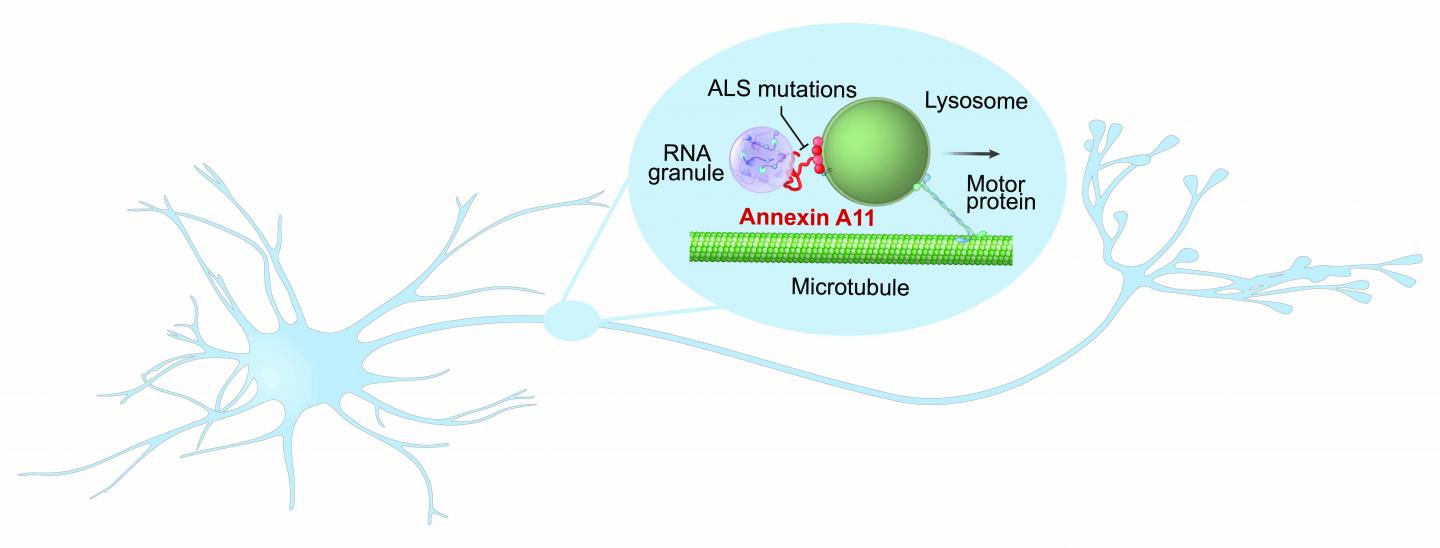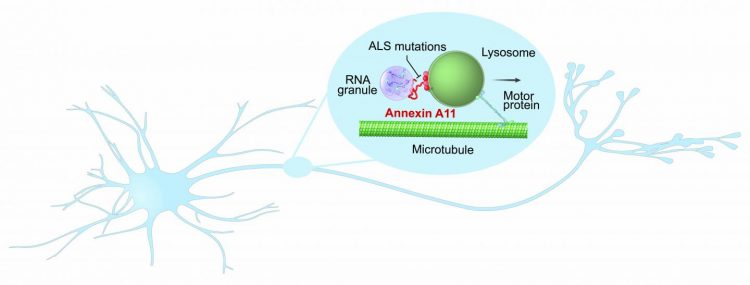NIH-funded study suggests a new pathway for treatments

Credit: NIH/NINDS
WHAT:
Affecting at least 14,000 Americans, amyotrophic lateral sclerosis (ALS) is a paralyzing and highly fatal neurodegenerative disorder for which there are no effective treatments. Scientists peered inside neurons and watched the workings of annexin A11, a gene linked to a rare form of ALS. They found that neurons may normally use the gene to ship internal housekeeping instructions via a newly discovered “hitchhiking” system and that disease-causing mutations may tie up deliveries at the cell’s loading docks. The study, published in Cell, was led by researchers in labs overseen by Michael Ward, M.D., Ph.D., investigator at the National Institute of Neurological Disorders and Stroke, part of the National Institutes of Health; Jennifer Lippincott-Schwartz, Ph.D., senior group leader at the Howard Hughes Medical Institute Janelia Research Campus; and Peter St. George-Hyslop, M.D., Wellcome Trust Principal Research Fellow, Cambridge Institute for Medical Research., United Kingdom.
Neurons, like other cells, constantly manufacture proteins, the cell’s workhorses. Instructions for making proteins are encoded in chromosomal DNA and stored in the nucleus. Manufacturing starts when DNA instructions are transcribed into RNAs, which are packaged as granules and transported out of the nucleus to other parts of the cell for assembly. Unlike in other cells, RNA in neurons may have to travel over great distances – sometimes up to four feet – down stringy axons or through dendritic branches. Using advanced live cell microscopy, the researchers found that annexin A11 plays a role in this process by helping RNA granules hitch rides onto traveling lysosomes. Until recently, lysosomes were mainly viewed as garbage cans that roam around inside of cells cleaning up waste. These unexpected results suggest that lysosomes might moonlight as RNA transporters.
They also found that disease-causing mutations in annexin A11 prevented hitchhiking, which, in turn, prevented RNA from being delivered to the far reaches of neurons. Many genetic studies have found that ALS is often caused by mutations in genes known to play roles in either RNA processing or the control of lysosomes. These results suggest that there is a link between these seemingly different processes and that understanding this type of hitchhiking in neurons may lead to new treatments for ALS.
###
WHO:
Michael Ward, M.D., Ph.D., investigator, NIH’s National Institute of Neurological Disorders and Stroke (NINDS)
Article:
Liao, Y-C; Fernandopulle, M.S. et al. RNA granules hitchhike on lysosomes for long-distance transport, using annexin A11 as a molecular tether, September 19, 2019, Cell; DOI: 10.1016/j.cell.2019.08.050
This study was supported by the Intramural Research Program at the NINDS, the Canadian Institutes of Health Research, the Wellcome Trust, the ALS Society of Canada/Brain Canada, and the HHMI Janelia Research Campus.
This press release describes a basic research finding. Basic research increases our understanding of human behavior and biology, which is foundational to advancing new and better ways to prevent, diagnose, and treat disease. Science is an unpredictable and incremental process — each research advance builds on past discoveries, often in unexpected ways. Most clinical advances would not be possible without the knowledge of fundamental basic research.
For more information:
http://www.
http://www.
neuroscience.nih.gov/ninds/
neuroscience.nih.gov
irp.nih.gov
NINDS is the nation’s leading funder of research on the brain and nervous system. The mission of NINDS is to seek fundamental knowledge about the brain and nervous system and to use that knowledge to reduce the burden of neurological disease.
About the National Institutes of Health (NIH):
NIH, the nation’s medical research agency, includes 27 Institutes and Centers and is a component of the U.S. Department of Health and Human Services. NIH is the primary federal agency conducting and supporting basic, clinical, and translational medical research, and is investigating the causes, treatments, and cures for both common and rare diseases. For more information about NIH and its programs, visit http://www.
Media Contact
Christopher Thomas
[email protected]
Related Journal Article
http://dx.





